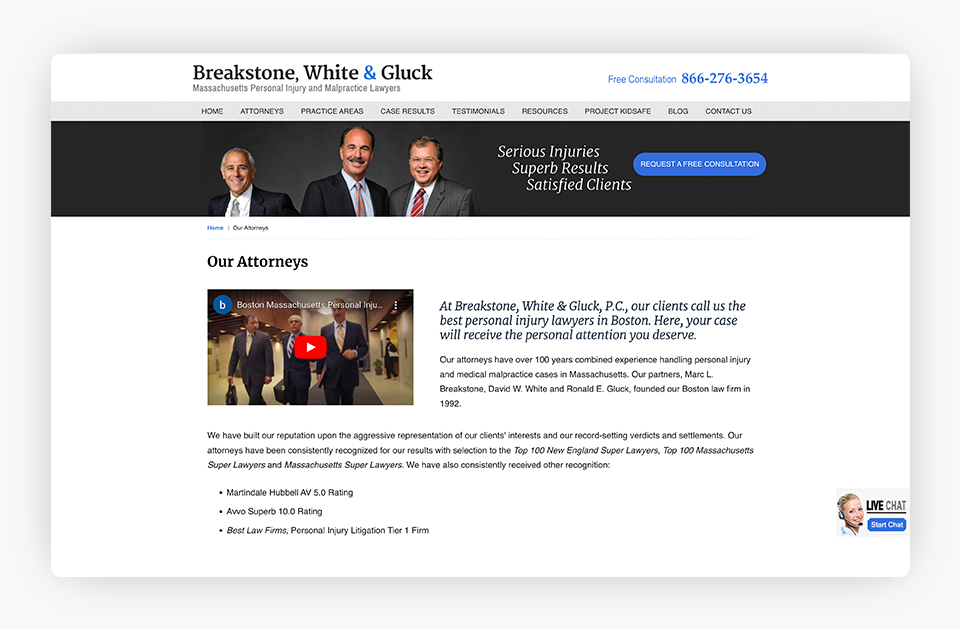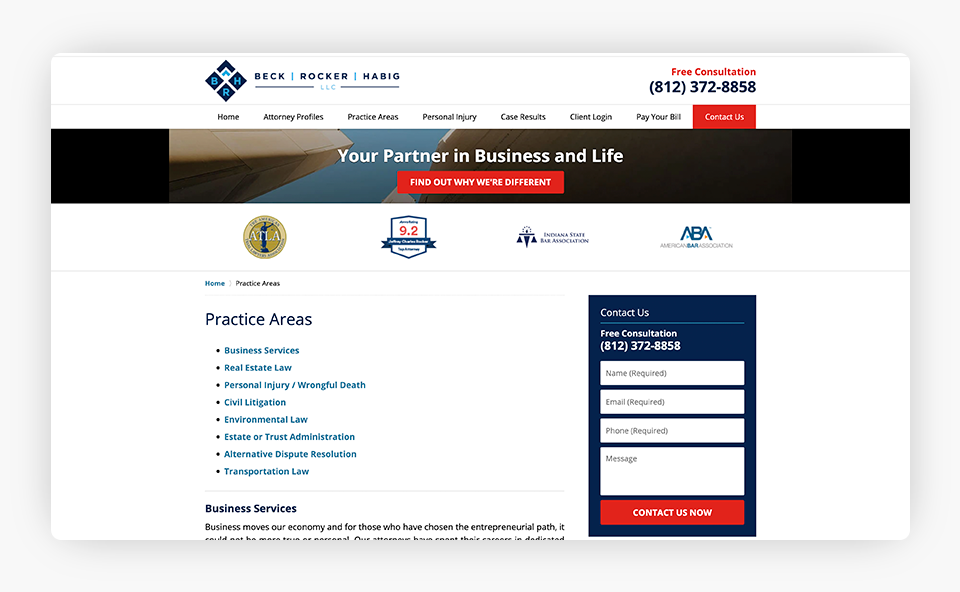We can’t send you updates from Justia Onward without your email.
Unsubscribe at any time.
Your law firm website plays a critical role in your legal marketing strategy. Creating a strong website can take time. Luckily, you only need five core pages to launch! Keep reading to learn more.
Watch this Justia Webinar playlist on YouTube.
Since this blog was published, Justia CLE & Webinars are now open to everyone, lawyers, other legal professionals, law students, and law enthusiasts.
Creating a strong website for your practice takes time! It also involves ongoing effort. After creating a basic site structure, many law firms will continue to integrate new content and expand their presence. Additionally, you will likely need to continue updating information for accuracy – such as changing laws or new office locations – as well as revisit your optimization strategies to ensure you continually use search engine optimization and website best practices.
Luckily, your website does not have to have numerous pages to go live and start connecting you with more clients! Instead, we suggest you focus on optimizing five must-have law firm website pages to launch your site. Then, continue to expand your content and add relevant pages to grow your site. While this may not be a one-size-fits-all approach, it can help your law firm start getting the benefit of a new website sooner, rather than later.
1. Homepage

Your website homepage is the face of your website. It will often be the most visited page on your site for users and is more likely to rank well in Google Search results than other pages on your website.
Think of your homepage as the first impression you make on potential clients. It should readily communicate who you are and what you do. It should be visually appealing and immediately catch visitors’ attention.
You also want to be sure you include key elements on this page. For example, we recommend a visually engaging header that incorporates a photo of you or your team. Use a catchy headline or slogan somewhere towards the top of the page. Then, explain more about your firm, your practice, and what you do.
Leverage social proof on your website homepage, such as testimonials, awards, and reviews. Showcase your successes, such as cases won and impressive settlements. You should also make sure you have integrated multiple, easy ways to contact you. For example, you want to ideally have a contact button in your header, a prominently displayed phone number, and an integrated contact form further down the page.
Watch this video to learn more about your website’s homepage.
Related Post: Questions Your Law Firm Website Homepage Needs to Answer
2. About Us

The “About Us” page on your law firm website is where potential clients learn more about your firm. Who are you? What makes you stand out from your competitors?
For example, are you a criminal defense attorney with prior experience as a prosecutor? Does your team have a combined 100+ years of experience in handling child custody disputes? Have you earned a specialization in a practice area? Tell people on the “About Us” page!
This is also a great place to share more about your firm’s history. For instance, when were you founded and why? Are you a multi-generational family operation? Something else? Tell your future clients.
Likewise, you want to be sure you share a bit more about your law firm’s philosophy and way of work. If you are involved in the community, showcase your firm’s commitment to public service. Include information about your different office locations.
Your goal on this page is to offer potential clients the opportunity to better understand your firm, who you are, and how you work. Not only does this ensure your potential clients have accurate information about your practice, but this information can build stronger connections with clients that help your law firm grow!
3. Attorney Profiles

If you are a solo attorney, this is likely a single page on your website. However, in a larger practice, you may have multiple attorney profile pages grouped in one section of your site. Regardless of the number of pages, this is a section you should have before your site goes live. Often, this section of your website is the second most visited area, behind your website homepage, because potential clients want to understand the background and qualifications of an attorney before making hiring decisions.
These pages may have many different names, e.g. “Our Team”, “Our Staff”, etc. Regardless of what you name this section, these pages are the biographies that share more information about the people working in your practice. Some law firms choose to only showcase lawyers on their websites. Others showcase both attorneys and support staff. Whichever route you choose, your goal is to share engaging, relevant insights into your team’s background and qualifications.
These attorney profiles should include a professional, engaging photo. They should discuss the person’s relevant experience and credentials. They should also showcase the employee’s awards/accolades and include a way to contact the employee. At a minimum, we recommend including a phone number, address, and contact form. However, some firms also choose to include email addresses and professional social media profiles.
Watch this clip to gain insights and tips to improve your attorney profile page’s content.
To learn more about creating a strong attorney profile for each member of your team, you can check out our previous Justia Onward posts, Drafting Your Ideal Attorney Biography and How to Write a Compelling Attorney Profile Page.
4. Practice Areas

This section of your website will be the heart of your future growth. It may start as a single page highlighting your key practice areas, but it will undoubtedly become a grouping of various pages that hold relevant information about your practice areas. How in-depth this structure becomes will vary based on the nature of your practice and your website goals.
For instance, if you have a niche practice focused on one or two main areas, the structure of this part of your website may not become overly complex. However, if you are a general practitioner handling diverse matters, you may end up with multiple levels of nested pages that organize your content for website visitors.
Consider the example of a family law attorney. At the outset, you may have one top-level page that highlights your core practice: family law. Over time, this will likely grow to include subpages with additional details on subsets of family law, such as divorce, child custody, adoptions, etc. You may want to drill down even further into these topics, such as creating additional pages within the divorce section for related issues, such as the division of assets or spousal support/alimony.
Likewise, if you want to convert more clients in certain subsets of a practice area, having pages focused on those topics can help! For instance, a car accidents page may suffice for a general explanation of what you handle in your practice. However, individualized pages on incidents like Uber accidents, bus accidents, and big rig accidents often increase your chances of converting potential clients with those exact issues.
At the start, the most important thing to remember is ensuring your potential clients know what type of law you practice. Be sure they have access to those details. As you continue to expand this section of your website, be sure to prioritize a strong organizational structure. This is important for both user experiences and search engine optimization.
Want to learn more about optimizing your practice area pages for Google and other search engines? We have information for you!
Watch this video to learn more about the content for your practice areas pages.
Check out this Justia Onward post to learn more about page optimization for Google. We also offer Justia Webinars about website content and structure for Law Firm SEO. You can access these recordings by upgrading to Justia Connect Pro.
5. Contact Us

Last but certainly not least, your law firm website must have a “Contact Us” page or section when it goes live. The goal of your law firm website is primarily to connect with current and future clients. These people have to be able to get in touch with you effectively.
On this page, you should list your office locations and addresses. You should have phone numbers, fax numbers, and email addresses (if desired). You will also want to include maps and driving directions. Finally, contact pages should feature a prominent contact form for website visitors to easily reach out to your firm.
Final Thoughts: Why Do You Care?
Your law firm website plays an integral role in helping your firm grow. It is the foundation of your SEO strategy and is crucial to enhancing your online presence.
While you will want to continue to add high-quality, relevant content to your site, these five pages serve as a strong foundation. Once these are set up, you are ready to “go live” with your site and continue to expand it as needed in the future.
Interested in a new, high-performing law firm website? Contact us to learn more about what Justia Elevate websites offer for attorneys.
Related Posts